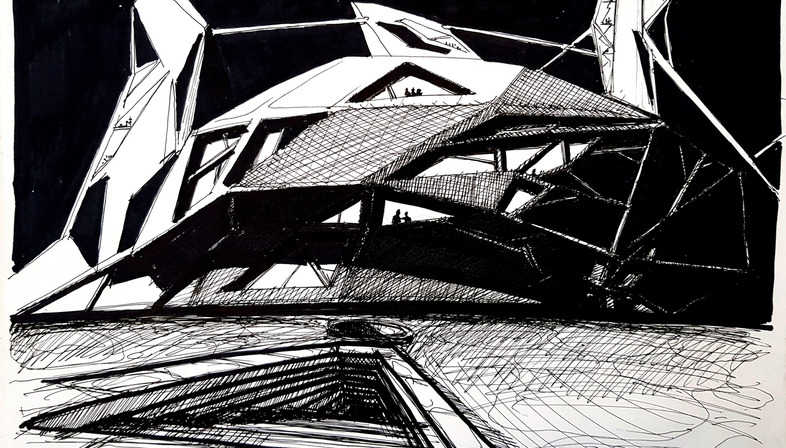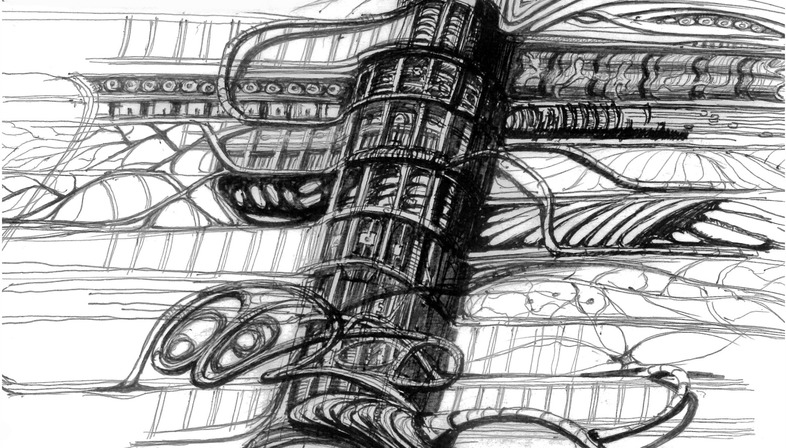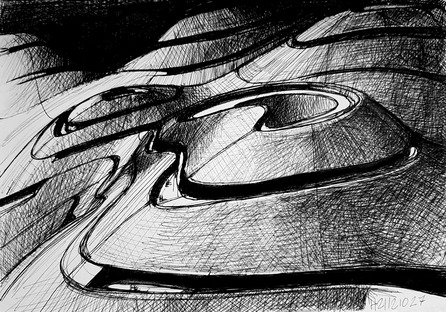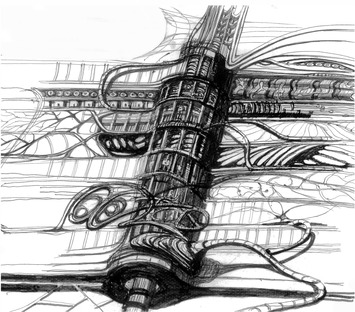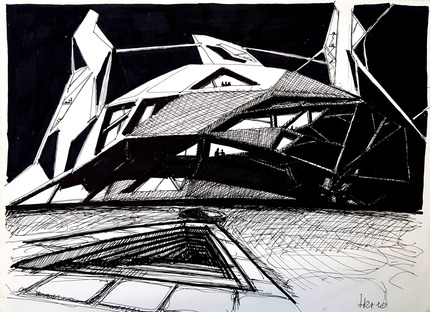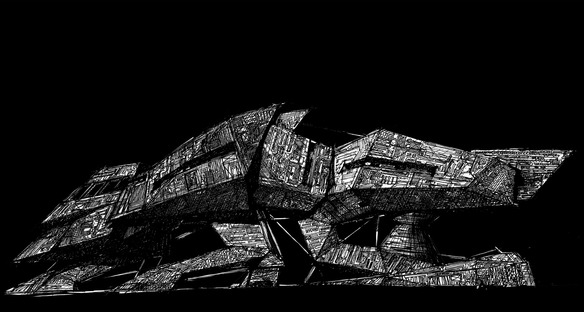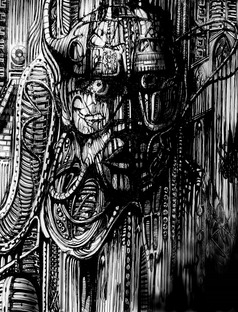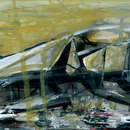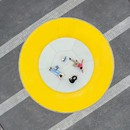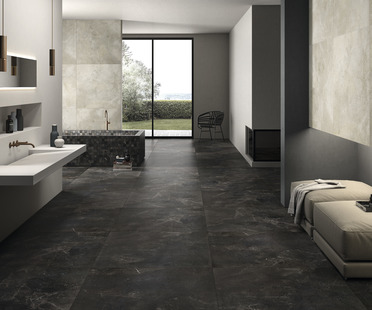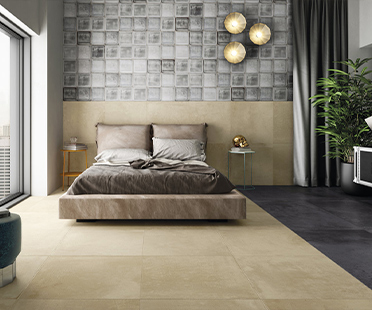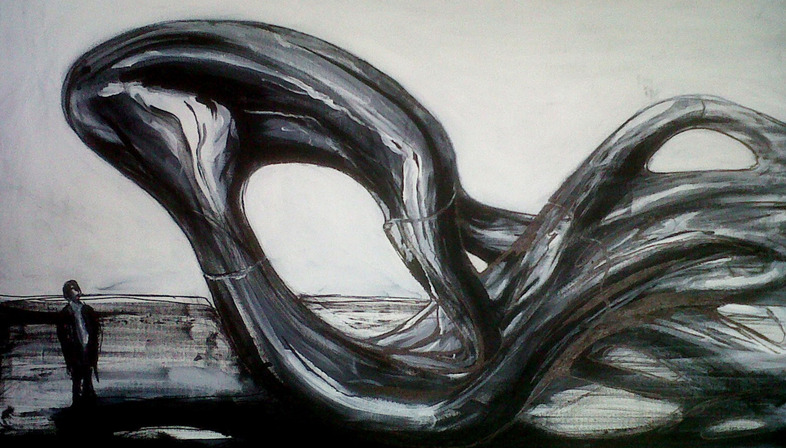 "We design environmental conscious buildings and smart cities to meet today’s needs without compromising the needs of the future generations”, Alessandro Melis.
"We design environmental conscious buildings and smart cities to meet today’s needs without compromising the needs of the future generations”, Alessandro Melis.It has be a long time that Alessandro Melis dedicates himself to investigate issues that are becoming increasingly critical, such as those related to global emergencies. Now, appointed as curator of the Italian Pavilion for the 17th International Architecture Exhibition of the Venice Biennale 2020, he sees realize, a dream that he has nurtured for a long time, to be able to offer a decisive contribution for a material and cultural change, regarding situations of great environmental risk. Hashim Sarkis, in line with the thematic choices that have been addressed in the previous years, urges the architect's responsibility towards society by requesting a reflection on the urgency for a more civil and sustainable coexistence, in a world in constant evolution, divided by great inequalities and divergences. To the question "How will we live together?", Melis accepts the challenge, selecting, among the multiple meanings of the word ‘together’: “together, as a planet intent on facing the various crises that require global action, so that we can continue to live”.
Addressing the need of important “adjustments”, alternatives, which cannot be postponed, he proposes, as a solution, the creation of ‘Resilient Communities’, which can deal with the current environmental and social pressure. Regarding the encouragement that has been extended to all participants who have been invited to include and involve other professions from artists to builders at the Biennale event, in the name of an architecture that must become “the reference point of a vast interdisciplinary commitment”, Melis has decided that the architectural communication will be contaminated without barriers by different forms of representation, in order to establish a more effective dialogue and to express itself more attuned to the contemporary dynamic context, continuously changing. The Industrial and Creative Arts have always conferred an additional value and a greater resonance to architectural design, even if they have not always been adequately evaluated in the Italian cultural panorama. Today architecture requires an exchange with other art expressions, part of the world of mass communication, such as comic book’s narrative formulas, gaming, augmented reality practices, graphic novels and cyberpunk style, able to provide communicative strategies with a strong impact, more coherent to the extremely innovative scenarios of that future that is waiting for us. This type of polyphonicity will be one of the focal point of the Italian Pavilion reminding us that from the interaction of artistic languages, not belonging to the same sector, regeneration of much higher value can arise. The architect should behave as the polygraphs, who, by 'linking the dots’ of many disciplines, give us a universal knowledge. He should do the same, as orchestrator of a crucial synthesis, essential for more feasible and less risky choices.
The architect Alessandro Melis has dedicated enthusiasm and years of study to deepen how to heal a city hit by the violent impact of a tremendous environmental crisis. It is through the collaboration with other sectors of specialization that he has always tried to help, making us understand how we could effectively contribute to the future of our urban reality. We have reached a point of severe disequilibrium in the evolutionary cycle and, in this crucial moment, which is oscillating between freeze and need for a move, we must opt for a radical change in the urban structure, helping our city to be more resilient, able to adapt to the important climate changes that are going to happen. These experiments that were result of hard sacrifices were not always conducted in Italy, but around the world. As Melis himself notes with some regret, his research has been encouraged and helped by foreign academies, such as the University of Portsmouth, in the United Kingdom. It is there that he is currently co-director of the Cluster for Sustainable Cities, an organization that aims to find innovative solutions in the field of sustainability through an interdisciplinary collaboration, which embraces architecture, urban planning, social sciences, ICT (Information and Communications Technology) and engineering. Always here he founded the Media Hub, a center born with the purpose of deepening the application of the latest technologies in the same fields of climatic and environmental design and which, according to his suggestion, integrates Bim, computation and fluid dynamics. The center offers an example of how to bridge research, learning and teaching, making use of the contribution of teachers and researchers. This commitment to the applied research is accompanied by a great virtuosity that characterizes him in the graphics.
An internationally renowned studio, Coop Himmelb(l)au, has often reiterated that architecture should be thought "as part of the 21st century, as art which reflects and provides a mirror image of the variety, vivacity, tension and complexity of our cities ", and Melis emphasizes the concept through the aggressive and incisive lines of his marvelous graphic representations. We witness compressions, dilations and fractures in the attempt to arrive to a sort of continuity. And at this point I want to open a parenthesis to dedicate to these drawings, that I find poignantly beautiful, an image I liked so much written for another architect, brilliant designer, Michael Sorkin, by his friend and studio partner, Mr. Vouk: "his initial conceptual drawings were dances of his hand, the choreography of his mind, like scans between the hand and the thinking”. As an excellent designer, as he is, Melis tells us and, perhaps it would be more correct to say, he screams out visions of fundamental radicality, that architecture can no longer procrastinate but that it is urgent to achieve, supported by the contributions of science. It is a new architecture, which arises from a symbiosis between nature and artifice, which, resilient to climate change, generates itself independently from human will.
Trying to face these issues with a minimum of competence, I discovered an extremely fascinated world and I think it would be interesting if many others could share it, penetrating the unknown folds of our daily reality. Deepening themes of Melis’ research, such as that of the autopoiesis, I explored a very intriguing theory that describes us as living beings, in continuous redefinition and modification for mutual adaptations with other living beings with which we enter into relation. Those statements that at the beginning seemed to me so radical and utopian started to appear still revolutionary, yet pertinent to inspire a design actually able to contrast and stem the difficult climatic and environmental calamities by which we are currently afflicted. Educator, deeply convinced of the mission that a teacher has towards his students, mission that he intends based on sharing and transmission of a work that must not interrupt but evolve, during his conferences, he often shows with evident pride the journeys in the present future, to which his students invite us with their visionary proposals. Melis founded in 1996 with Gian Luigi Melis, Heliopolis 21 Architetti Associati, an architecture and urban design studio, with offices in Pisa and Berlin, which mainly deals with low energy public buildings such as universities, concert and gym centers, and hospitality. In his projects the theme of resilient communities is a fundamental part and one significant example, that I can mention, is offered by the proposal for the Stella Maris Hospital in Pisa. It is the first and only hospital for neuropathologies of children’s development age, for which the architect has foreseen and created a series of opportunities, to use his words 'redundancies', which we can read in terms of resilience.
I have the pleasure of asking a few questions to the architect before our next encounter Onstage.
1. I heard you talk about analogies between moments of great crisis that would repeat themselves during the human evolutionary cycle. You focused on a very difficult period that was experienced in Italy in the 1300s and you highlighted several similarities with the current era of severe environmental crisis. It was extremely interesting and I would like you to share it with our audience.
Imagine a world where the population has reached the maximum expansion possible compared to the available resources. Within this framework, a climate crisis that drastically reduces agricultural productivity, dramatically hits the most vulnerable parts of society, then an epidemic wave that affects everyone indiscriminately. The mini glaciation and the famines of the fourteenth century followed by the plague of 1348, making the necessary distinctions, remind us of something that is happening today. This example is the most obvious, but not the only one that we can mention, especially if we consider the last 200,000 years of the Sapiens. We could cite the coexistence of Neanderthal or the case of Easter Island. Now, what I find really interesting in the example of the fourteenth century, is what happened after the crisis. While we imagine the downfall of that society, which has collapsed, instead we observe a radical reconstruction, within a few decades, guided by the creative ability of man. According to the paleoanthropologist Heather Pringle, this type of propulsion that tends towards visionary creativity is characterized by the use of associative thinking that manifests itself through transdisciplinarity and the convergence of arts, technology and sciences. It is therefore not surprising that polygraphs and extremely complex personalities who are today ascribed by us to the world of art and architecture are at the forefront of the Renaissance.
2. In this moment of painful and very serious emergency there is a certain tendency to speak of an 'urban scale' more at a 'human scale' and of an architecture that better expresses the concept of 'community' in the forms, with an open reference to the Renaissance and to the relationship of that time between individual-city-landscape. Does it seem possible to reconcile a similar idea with your future visions of a radical city?
I would also go beyond the urban scale. Let me explain: in the following years architects will have to respond to three different objectives. The first is operative, on the regeneration of the existing urban fabric, in terms of resilience. Architecture will have to answer to criteria of functional adaptability and to increasingly extreme and constantly evolving conditions, which we can rarely foresee a priori. This operative level aims to protect communities, during the phase of change, with tools that we have available and that we can control in the medium term. The second level is that of the urban scale. The paradox is that the negative effects of climate change will be suffered by those who are less responsible for what has been caused, considering that around 40% of CO2 emissions depend on the determinism of the urban planning. Surprisingly, we are convinced that the problem lies in the informal parts of the city. Instead it is legitimate to ask ourselves what we can learn from these conditions in terms of diversity, and social cohesion with low environmental impact.
In this second case, the purpose is to minimize the effects of an inertial society model, less inclined to radical change. Here we can talk about climatic design, passive and active devices applied to the urban scale, alternative transport, fluid dynamics and urban farming studies, just to mention some of the current trends. The third level, the most important, which requires reflection on the architect's strategic role, concerns the need to design a new form of alliance between humanity and nature in an ecological key. This last effort implies a philosophical reflection about of the concept of city and architecture as we know them today. The transformation cannot therefore ignore a reinterpretation of the society. Here, unfortunately, the architects are absent and prefer that others deal with this issue. Among the messianic figures who have dedicated themselves to the study of the city, we could mention Louis Mumford to Jane Jacobs. Today Deleuze, Lacan and Zizek are highly cited by architects à la page. Serge Latouche and Tim Morton have a great influence on sustainable architecture. The first with the concept of degrowth calls into question the privilege of certain communities, compared to others in the use of the planet's resources. According to Morton, with Dark Ecology, the problem is precisely the anthropocentrism of communities, to be reinterpreted in an object-oriented ontological vision, inspired by Heidegger.
Returning to the current events even if there is no specific correlation between environmental conditions and the spread of the plague, until a few months ago I used the analogy with the crisis of the fourteenth century to explain both the fragile equilibrium of the ecosystem balance that binds food production and our society that has its most powerful representation in the cities, to underline the growth of health emergencies in the coming decades, due to the climate crisis. According to Ilaria Capua, the COVID-19 pandemic also confirms the critical relationship between human settlements and environmental problems. Others go even further referring to a more immediate relationship between climate change and the pandemic. The fact is that the environmental causes of the spread of viruses and diseases have long been known. Tropicalization of the climate can favor the transmission of dengue, for example, while the reduction of rainfall in North America is considered a risk for the emergence of an outbreak of viruses that proliferate in arid climates such as those of the West Nile. However, the spread of viruses, due to urban pressure on animals carriers, will be only one of the negative health impacts of the environmental crisis on our society.
The World Health Organization says that the impact of climate change on air quality, drinking water and food supply will cause approximately 250,000 additional deaths per year between 2030 and 2050, due to a combination of malnutrition, malaria, diarrhea and the effects of the heat. Direct costs for damage to the health are estimated at $ 2-4 billion per year by 2030. This will have important effects on informal settlements as areas with weak health infrastructures - especially in developing countries – that will be the least able to cope without assistance to prepare and respond. We already know today that these conditions are the perfect breeding ground for Ebola in the Kenema and Freetown slums in Sierra Leone. In the Global South, urbanization rates are very high. Sierra Leone is urbanizing at a rate of 3% every year and in 2005 over 97% of its urban population lived in slums. Let us remember that this is no longer just about Africa. In the United States, the impact of COVID-19 has been very strong against homeless people and ethnic minorities.
3. You has devoted much of your studies to the Ideal City of Leonardo and you are currently working on his anatomical drawings, in parallel with the theme of the evolutionary biology, as described by the paleoanthropologist Stephen J.Gould. How do you explain your interest in disciplines that would seem to be not so connected to the world of architecture?
As Hans Hollein states 'everything is architecture', intending architecture as a synthesis and encounter between disciplines: through technology and art, a physiological fact, the physical comfort and the most complex requests of the psyche, must ecologically combine with the notions of climatology and physics, that are essential to understand the fluid dynamic interactions between artificial matter and the troposphere. Sometimes I find arrogant our claim to feed only on architecture as final product of this associative process. I believe that Leonardo, like all Renaissance polygraphers, certainly belonged to the category of those more interested in the genotype of architecture, rather than in its phenotype. Many colleagues, in recent years, not finding, in architecture books, answers to emerging questions of the architecture itself, have turned their attention to economics and philosophy theorists. Instead, I believe I have found answers, including practical ones, not in the alteration of the ideas, but rather in a change of point of view, from the observation of the context, and the nature. This is why I am interested in disciplines, such as biology, botany and paleoanthropology, in which the conditions of crisis between man and nature have been studied for a long time, in a perspective that goes beyond the 10,000 years of existence of the conventional architecture (such as of the philosophy and the economics).
According to Gould, the perspective of the evolution of biology minimizes the risks of confusing an expansion of a datum deduced from the evolution as a trend of progress. This mistake in planning has occurred hundreds of times. The heroic phase of modern cities, and the epic of the car are an example. Even the current architecture seems unable to grasp the real position that man occupies within the ecosystem and, consequently, to realize the epochal crises. For example, with regard to the pandemic, discussions are wasted on the need for a future city where distance is possible, accepting instead the urban compactness, which, in the literature, favors the mitigation of Climate Change. Once again, marginal information is confused with a trend, and the fact that it is more strategically important to think of a new alliance, in an ecological key, between man and nature, is neglected. This is because, as Freud said, every revolution of the society is accompanied by a fall of men from Olympus, where they narcissistically placed themselves. As ocurred during the revolutions of heliocentrism, Darwinian evolutionism and the discovery of the unconscious in opposition to rationalism, today it is the environmental crisis that dethrones humanity and brings them back to the edges of nature and, hopefully, at the heart of the ecosystem. This implies a new form of symbiosis, between environment and man, which perhaps is not even called a city.
Virginia Cucchi
Credits:
Heliopolis 21 Architetti Associati:
https://www.heliopolis21.it/
Drawings of Alessandro Melis










